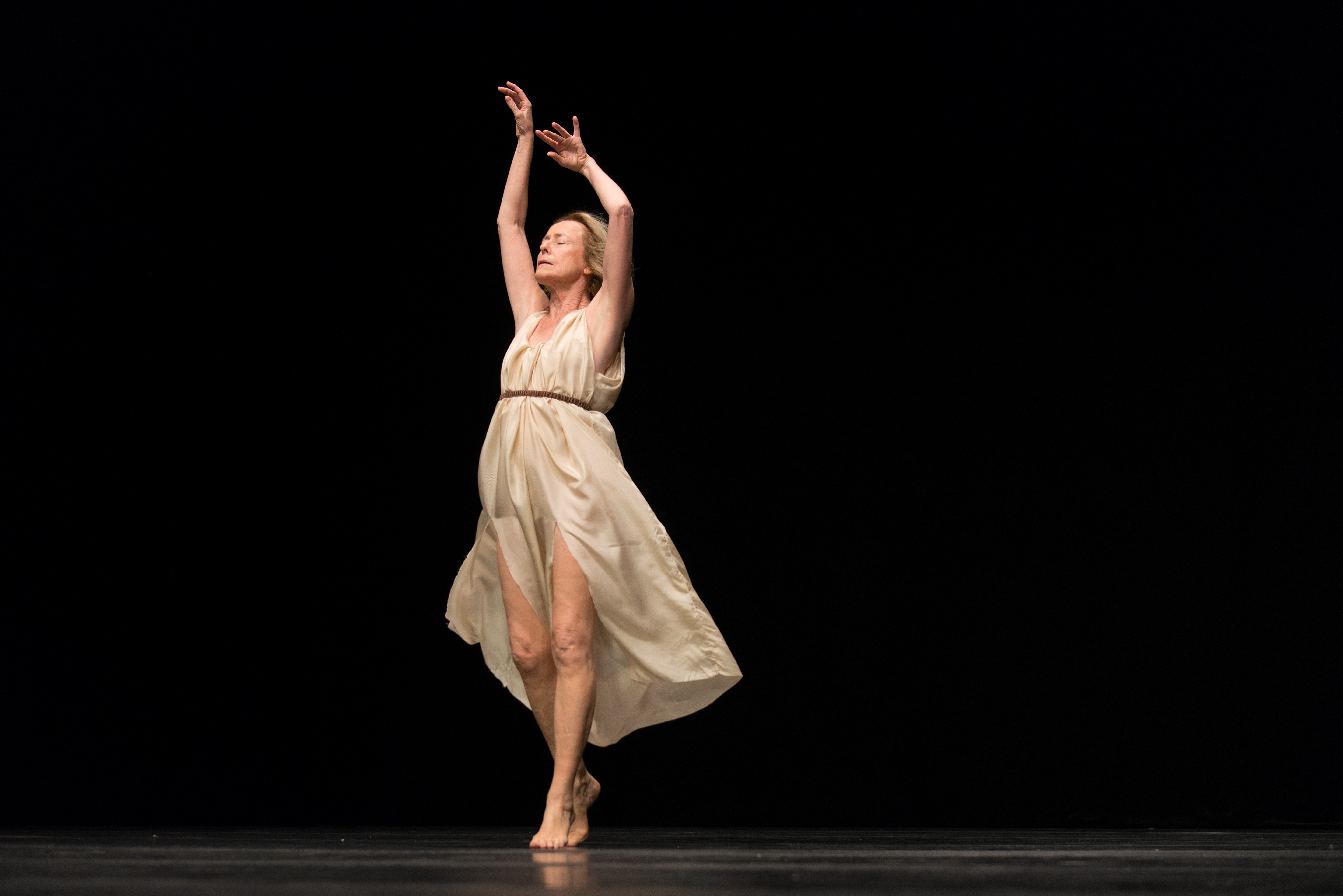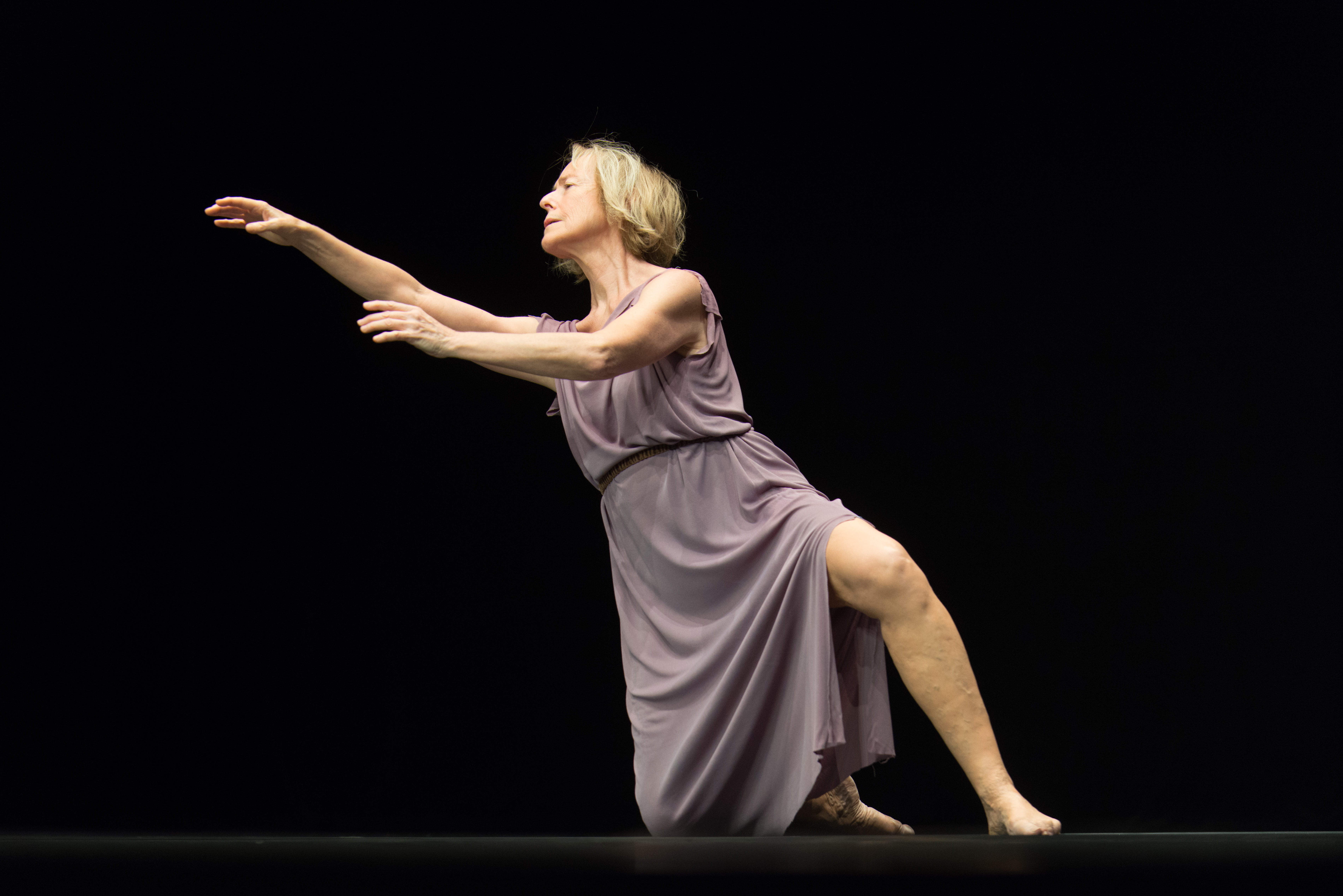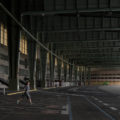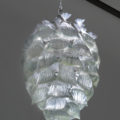ON THE DISPOSITIVE OF MEDIATION: JÉRÔME BEL AND ISADORA DUNCAN
In all live performances, there is an exchange between the performers on stage and there is a exchange between the performers and the audience. These two levels of communication must always arise because they guarantee the uniqueness of a performance. What is special about Jérôme Bel’s production Isadora Duncan is that it does not understand Isadora Duncan’s dances as an object of exchange, but rather their interpretations. The dancer Elisabeth Schwartz interprets six dances by Isadora Duncan as faithfully as possible by performing them, and she turns these interpretations into an object of interpretation for the audience itself.
Since Jérôme Bel presents dance as a medium of interpretation and translation that is always in motion, it seems appropriate to us to write a two-voice text about it.
We get to know Isadora Duncan’s biography through her choreographies. Born in San Francisco in 1877, the dancer was fascinated by Greek aesthetics, which she first encountered in the form of paintings on antique vases. But she was not a rare connaisseuse. Greek mythology and ancient architecture experienced a new revival in the United States at the beginning of the 20th century. Buildings were built in the historicist, neoclassical style and the fashions, which were still very corset-heavy, were inspired on the dresses of Greek goddesses through so-called „Empire“ cuts. Isadora Duncan was also oriented towards the style of classic tunics, with light, waving fabrics. In those days, these cuts, which gave deep insights onto the body, were still considered very revealing, even scandalous. So it wasn’t only Isadora Duncan’s dances that radiated lightness and were emotionally guided. Her airy dresses gave her the freedom of movement she needed to develop her dances far from the conventions of the time, quoting ancient ideals of beauty and translating them into her modern expressive dances. The choice of music was also fundamental. Waltz by Schubert, Préludes by Chopin and studies by Scriabin.
Through the liberation of the dancing female body, the movements interpreted by Elisabeth Schwartz appear new and modern. Even more than 100 years after their creation. As she describes it herself in a radio programme, Isadora Duncan’s dance is about a kind of suspension, i.e. a tension between strong impulses and gravity. A leitmotif of her dances is the wave, which she often used as a symbol of attraction or simply as the embodiment of waves. Waves and in a broader sense dancing was for her nothing but a game with gravity. The academic ballet, on the other hand, depicts the dancers as light, airy bodies that almost fly. This kind of dance tends to reject gravity.
The break with the academic classical dance mentioned here is by no means a renunciation of grace and precision. In Jérôme Bel’s production, almost every dance is performed three times. One time with or without music, one time without music but with keywords that explain the meaning or impulse of each movement, and one last time with music. The last time, the audience knows the intentions behind the gestures, and notices that every movement is exactly identical every time. The positions of each part of the body are always the same. In this sense, precision is not reduced despite the renunciation of academic rigour. And there is almost no need to tell that density and constancy are much more significant qualities in a space of freedom than when thoughts and motions are restricted in fixed forms or codes.
By distancing her work from academic dance, Isadora Duncan questions the relationship of the body to fundamental elements. How is the sea perceived by a human body? How can this perception be translated into motion? What is music and how does it move the body?
It is precisely from these fundamental, newly asked questions that an aesthetic of the reduction arises. This refers to a mode of representation and a way of thinking in which every movement stands for a feeling or an idea. Isadora Duncan’s dances are sentences: They consist of words whose associations and specific arrangement make sense and trigger feelings. And these words are translated into gestures. Behind every motion is an idea that can be expressed with words. The images that arise from this process are sometimes very obvious in Duncan’s pieces. The mother lulls the imaginary child. She strokes it. She says goodbye to him with a raised hand. The communist fights by strongly stretching her fist forward. However, these gestures are so clear and above all so reduced that they are never redundant.
It seems that Isadora Duncan has been searching for the right movements, positions and spatial constellations the same way a poet would be searching for suitable and reduced words-compositions. As well the cubist painters – Duncan’s contemporaries – reduced the drawn forms until they reached the representation of their quintessence. Until the point where only the fundamental core was conveyed: The core released from all superficial peels. The sculptor Auguste Rodin worked in a comparable way with his fragments: One foot alone suggests a certain posture, an impulse or a stability. One foot is enough to imagine the whole body. In 1990, Elisabeth Schwartz has even staged Isadora Duncan’s dances in association with Rodin’s sculptures. In their quest for reduction, the two artists have both achieved an aesthetic where beauty lies in the art of evocation.
JÉRÔME BEL’S PRODUCTION
Jérôme Bel stages Isadora Duncan’s life in the form of a timeline where her dances serve to visualise her wealth of experience and the development of her movements, which are always related to her experiences and emotions as some kind of reflection of them. Born in 1964, the choreographer stands for a „conceptual“ dance. Similar to Duncan, he releases himself from the corset of classical stagings with a spectacular stage design and tries his hand at conceptual theatre practice, which, however, is much more than a simple representation of movements. Thus his choreographies are based on semiological and poststructuralist theories such as those of Roland Barthes, Guy Debord or Michel Foucault.
Jérôme Bel nears Roland Barthes‘ semiological approach by translating signs into movement and vice versa, making this translation process a fundamental theme of his work. Similar to Bertolt Brecht’s concept of the „Fourth Wall“, which must fall down, and Foucault’s idea of the theater as a dispositive, Bel also goes beyond the stage space in his theater practice, often leaving its architecturally as well as spatially fixed field and involving the audience as the fundamental instance for the performance. That way the spectators become participants. Jérôme Bel also follows the idea of Guy Debord, who sees the individual free-will jeopardized due to the capitalist „society of the spectacle“. According to Debord, the awared creation of situations would give the possibility to turn passive-powerless observers into active participants in life, which would be an opportunity to change social structures. This approach could also be considered in the tradition of Jacques Rancière, who sees in the audience emancipated spectators who think for themselves and carry their acquired knowledge. Jérôme Bel aspires to offer the spectators an opportunity to become active participants.
With these theoretical references in mind, we can now devote ourselves to a central theme of Jérôme Bel and Isadora Duncan, which has already been mentioned to some extent. Right at the beginning of the performance of the conceptual piece Isadora Duncan, it becomes clear what motivation unites the two choreographers: Mediation.
Mediation as „art mediation“, „dance mediation“ and „dance pedagogy“ in the sense of teaching and conveying content through practical exercises was fundamental for Isadora Duncan, who taught her students – the so-called „Isadorables“ – the choreographies she conceived. However, her „Isadorables“ didn’t have to perfect the dances as they would have been enjoined to do in ballet schools, where the perfection is understood as immutable and the bodies have to submit to the rules of the choreographies. Isadora Duncan understood dance as an expression of the innermost emotions – for the assimilation of feelings – and as an opportunity to change society. As a way of learning together, the mediator (Jérôme Bel’s assistant) relies on collective intelligence to rehearse Isadora Duncan’s choreography pre-performed by Elisabeth Schwartz and then left to the group of twelve spectators spontaneously invited on stage.
Jérôme Bel’s working method is made transparent: the method is the object of mediation itself. The core of the choreography becomes tangible. Jérôme Bel’s assistant, who reads Isadora Duncan’s biography from the very beginning, concludes by saying that the teaching of the choreographies, which was more important to Isadora Duncan than anything else, was successful again that night with us, the audience.
At the beginning it was almost to be feared that Duncan’s choreographies would only be an illustration of the biography read aloud: we are told that Isadora Duncan found her inspiration in Greek antiquity. And so we are shown how she translated „Dionysos“, „Satyre“ and other Greek patterns into motions.
But very quickly the dances play a more central role and the text becomes an accompaniment of them, an explanation. A total of 6 choreographies are performed. Through the 3 repetitions of each choreography and the reading of keywords which enlighten the intentions of each motion, every spectator can deeply understand Isadora Duncan’s work. It is also possible to get the structure of her choreographies. Just as Swann understands Vinteuil’s sonata ever more deeply in Proust’s In Search of Lost Time after he has been listening to it several times. In the third performance of the same choreography, one can, like Swann, focus on secondary details and understand the beauty and complexity of the piece. And at the end, what you’ve missed during the first performance seems to be even more important than what you originally took for the most beautiful part of all. The audience even laughs when the „Dionysos“ movement appears in the piece called The Musical Moment (after Franz Schubert’s piece with the same title). There is laughter because the reference had been made understandable for everyone.
Through this procedure, where each piece is repeated several times with lyrics or music, a certain understanding succeeds in the audience. This also means that Isadora Duncan’s, Jérôme Bel’s and Elisabeth Schwartz’s working methods are revealed and made accessible. At last this is not about Isadora Duncan’s dances being performed perfectly and in the original context (the music is played by a computer and not even with a real piano), but about her work being conveyed now and in a contemporary way. So that all spectators should feel interested. Jérôme Bel also asks the question of the interpretation: Elisabeth Schwartz interprets Isadora Duncan’s choreographies with her own understanding and her own story. Dance is presented and conveyed as a subjective object of interpretation par excellence. Therefore, the decomposition and the revelation of the working processes are essential: they allow us to appreciate each dance better.
Whoever sees a pearl for the first time is fascinated by its beauty. And those who know how the pearl was made by a shell will admire its splendour even more.

Jérôme Bel, Isadora Duncan, ©Camille Blake
Cover: Isadora Duncan ©Arnold Genthe
Julia Ben Abdallah and Janine Muckermann
Short bibliography (French and German)
France Culture, Une vie, une oeuvre, “Isadora Duncan ou l’art de danser sa vie (1877-1927), Programme from 12.17.2016, Irène Omélianenko https://www.franceculture.fr/emissions/une-vie-une-oeuvre/isadora-duncan-ou-lart-de-danser-sa-vie-1877-1927
“Jaillissements. Isadora Duncan et Auguste Rodin”, 1990 https://www.numeridanse.tv/videotheque-danse/jaillissements-isadora-duncan-et-auguste-rodin?s
http://www.jeromebel.fr/index.php?p=5&lg=2&cid=205
http://www.theater-wissenschaft.de/kongresse/theater-als-kritik/
Tanz im August 2019
Deutsches Theater Berlin
August 16th and 18th
https://www.tanzimaugust.de









